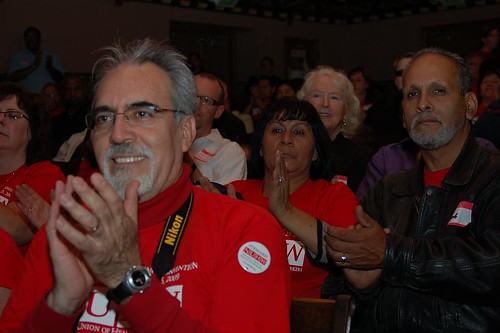
(image courtesy of the NUHW Photostream on Flickr)
With the illustration complete as to what is at stake for those who are still stuck in Hotel California, it was time for Sal to take back to the stage and let the troops know what was in store for the upcoming weeks and months. The plan of action basically boiled down to a couple of key concepts:
- Collect petitions (which has already been to a large extent done).
- Win the elections that have been permitted thus far.
- From that "foundation" created with the elections, generate the monetary resources necessary to bargain contracts in areas where we have won, as well as to continue the fight in areas that are being blocked by NLRB.
- Get NLRB-blocked facilities through election, then win those elections as well.
- Repeat the above sequence.
The first two fault line elections are coming up very quickly, with ballots going out this week at Doctors Hospital in San Pablo, and with the Fresno County IHSS group coming up in May, and that much organizing and effort - and money - was going to have to be dedicated to those two elections to bring them home to NUHW and to get the ball rolling.
Sal then took some time and explained about the differences in what he and his group was able to achieve when in charge of UHW, and what SEIU has done in the last three months, and will continue to do while they are in charge of Zombie UHW. The negotiation pattern of the prior leadership of UHW under Sal Rosselli, which will continue into the future with NUHW was and is quite simple - establish contracts that are widely considered to be the industry standard (as was the case with the 2005 KaiPerm contract) and then use THAT contract as a standard by which to measure all other contracts. The Kaiser contract was seen as a "floor" position from which to improve in all other areas - and this was done at Mariner/SAVA SNF facilities when parity was achieved for their employees to KP pay and benefit standards - a contract that is far superior to the current "template" contract approach employed by SEIU.
Even now, it is clear that SEIU is beginning to "lower the floor" at Kaiser, having already adjusted the lump-sum pension benefits to Kaiser's liking (having done so without a vote of the membership to this unilateral change), and SEIU is now beginning to make noise about altering the employment and income security provision which is one of the reasons why the KaiPerm contract is thought of as industry-leading. SEIU is also making noise about allowing the different KP service areas to "adjust" their payroll levels to suit the local economy or local financial needs, this coming less than two years after KP was finally forced to do away with the two-tier wage system that had existed at KP for over a decade. It was and is the NUHW belief that individuals doing the same job, with the same qualifications, and with the same skills, should be paid the same wage, statewide.
Sal put the NUHW contract negotiation approach quite simply: "We will raise the floor, and thereby we will continue to raise the ceiling." Meanwhile, SEIU is perfectly happy to drop the ceiling at the behest of the management, and thereby allow the ceiling to crumble about the heads of its membership.
Sal then started to get into one subject which was on everyone's mind - what's going down on the legal front. As we all know, the main stated point of contention for Zombie UHW was the need to change the jurisdiction of the UHW long-term care workers, moving them into ULTCW - but as we all know, that hasn't happened yet. The NUHW lawyers evidently had gotten a recent opportunity to ask Eliseo Medina and Dave Regan about that question, and their basic response was that it was only the decertification petitions which were keeping the long term care workers in UHW - for reasons which I can speculate upon, but I don't think it needs a lot of explanation.
Sal stated that there were all kinds of new opportunities before us, and not just in California, either. There are many un-unionized hospitals in the HCA system, in Tenet, and in others. Furthermore, there is a great opportunity to organize the IHSS workers in San Francisco and Sacramento counties. And if we can break the NLRB logjam, then the potential is there for NUHW to be even larger than UHW was in its heyday.
With this done, it was time for Sal to yield the rostrum to John Borsos, who has been spearheading the NLRB fight - and here is the time when everyone started sitting forward in their seats to listen...
...and you can read about it in Part Five, to be posted shortly...


No comments:
Post a Comment
Note: Only a member of this blog may post a comment.